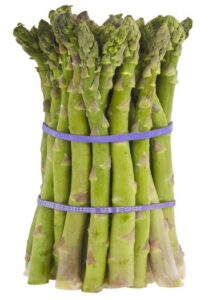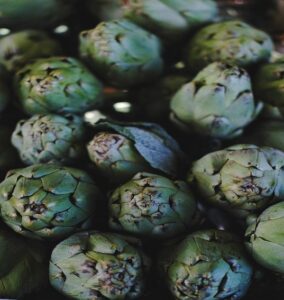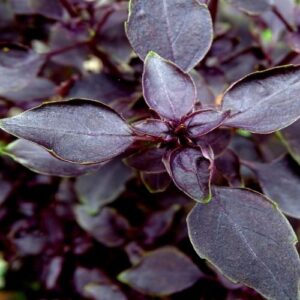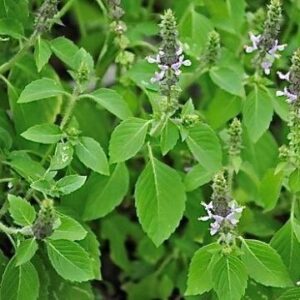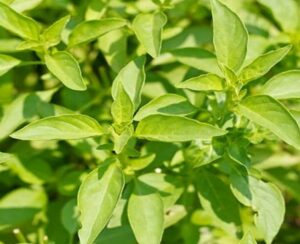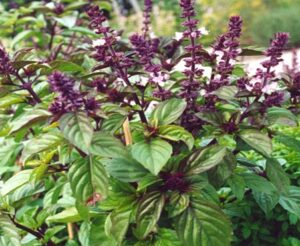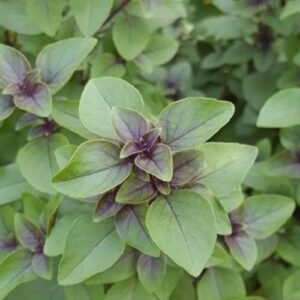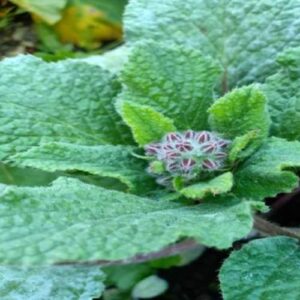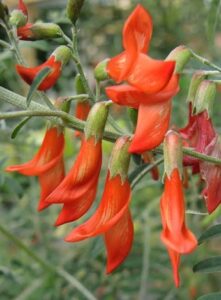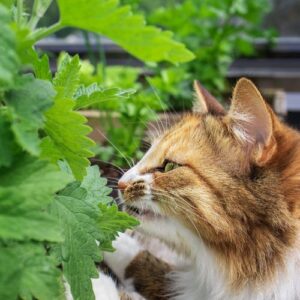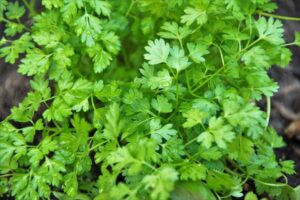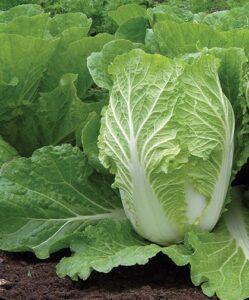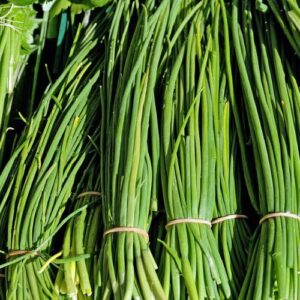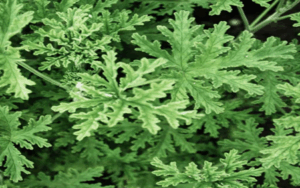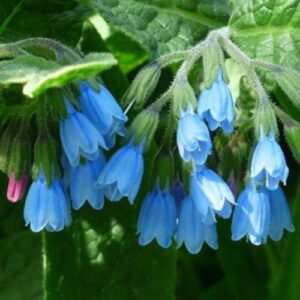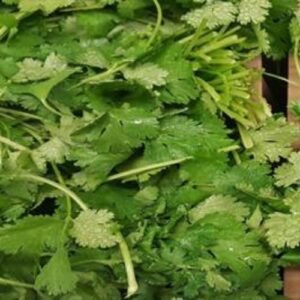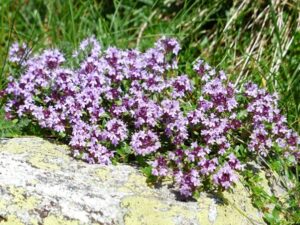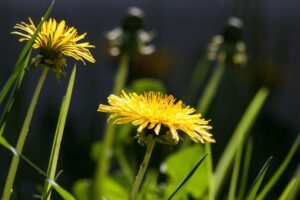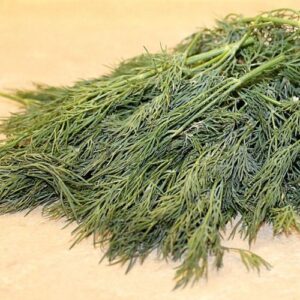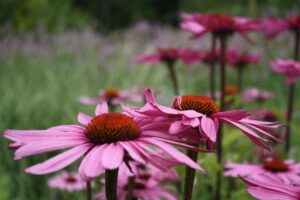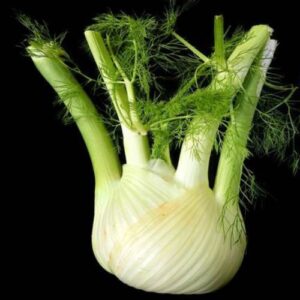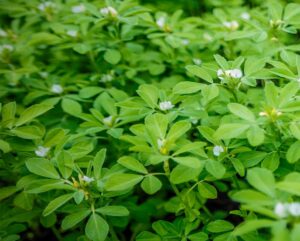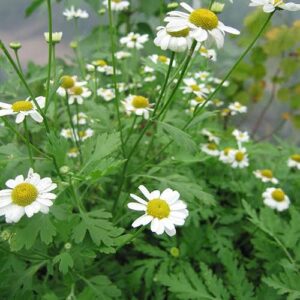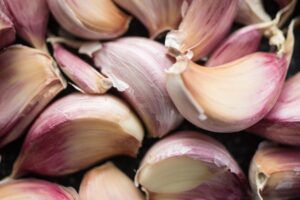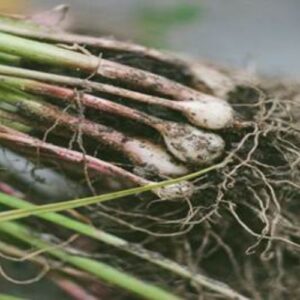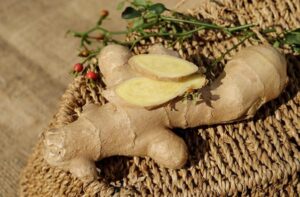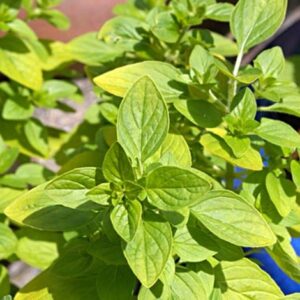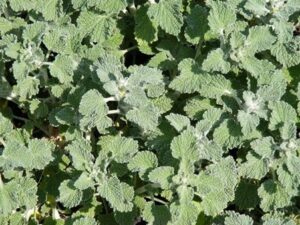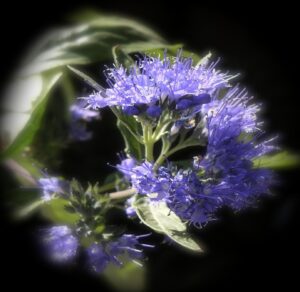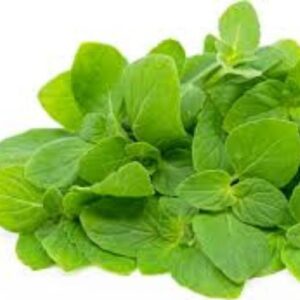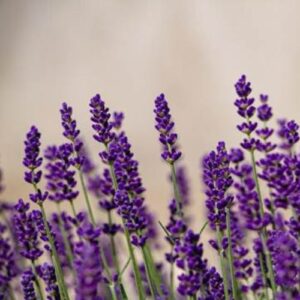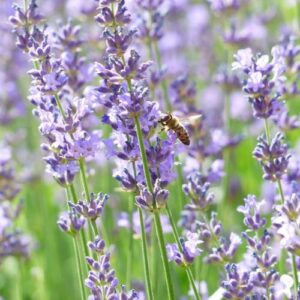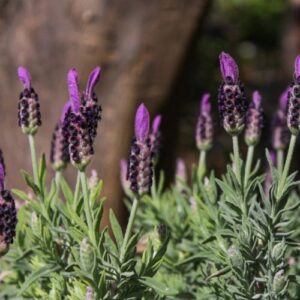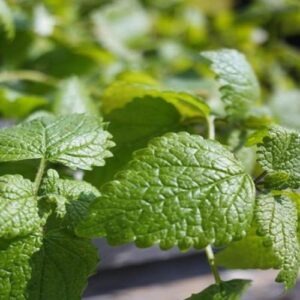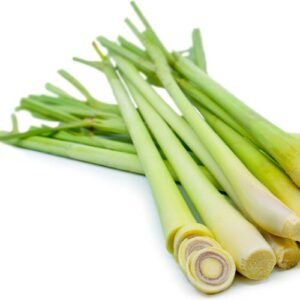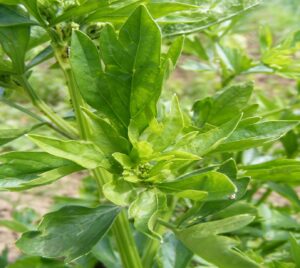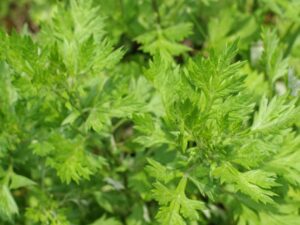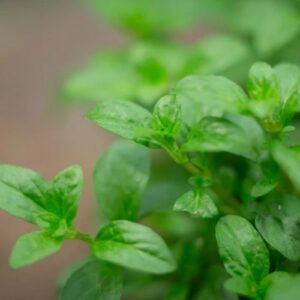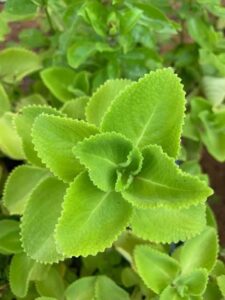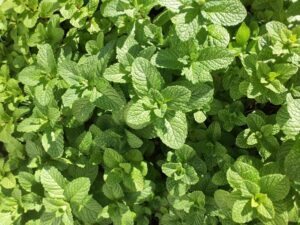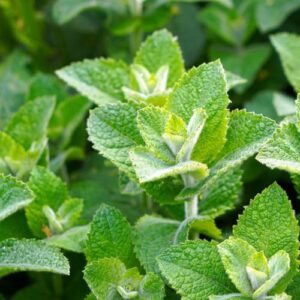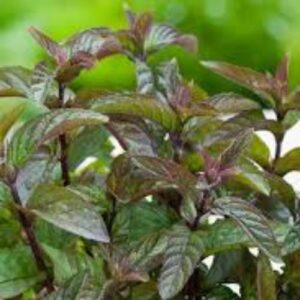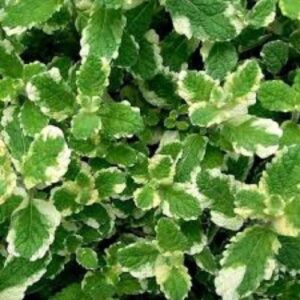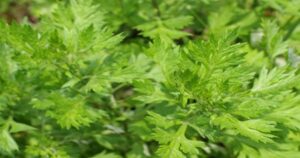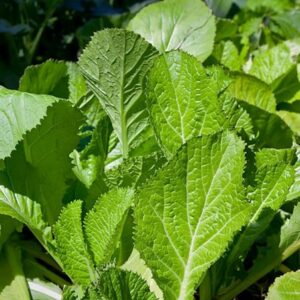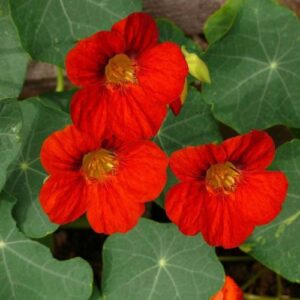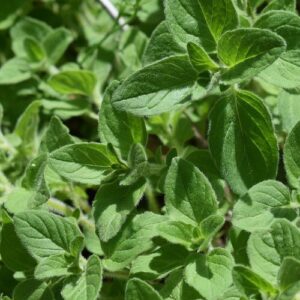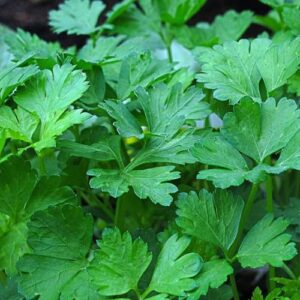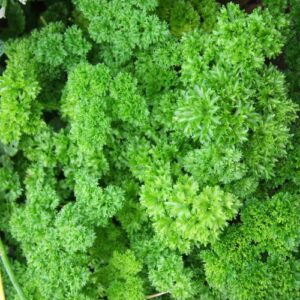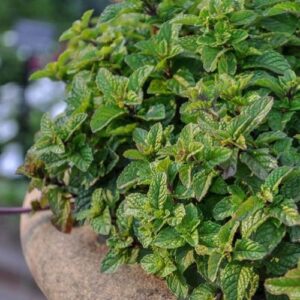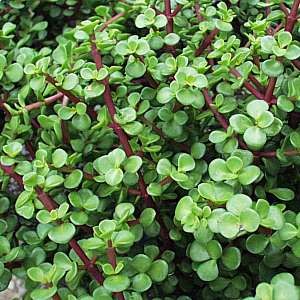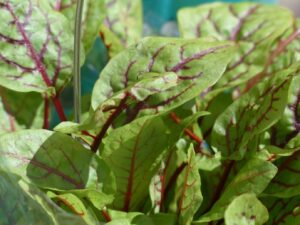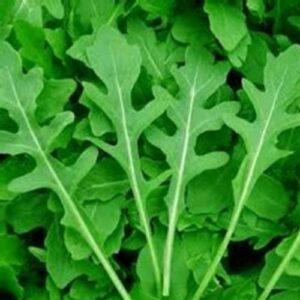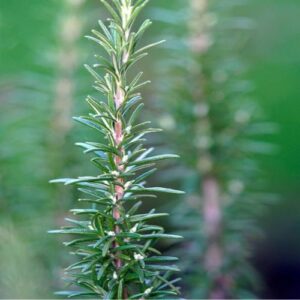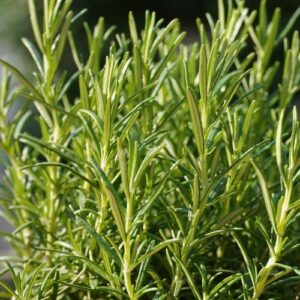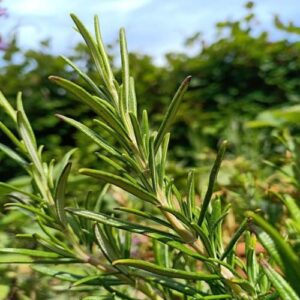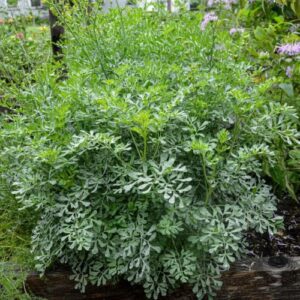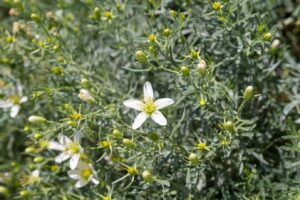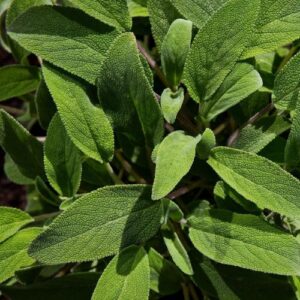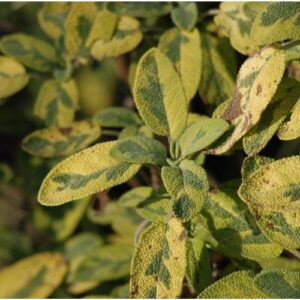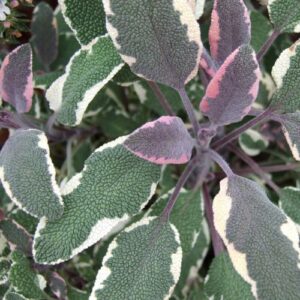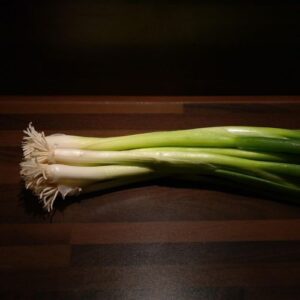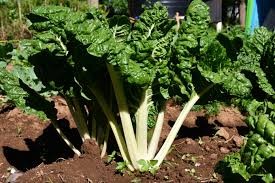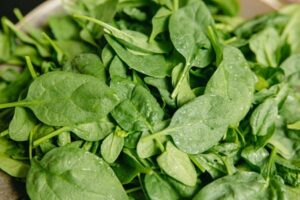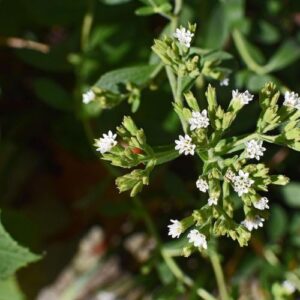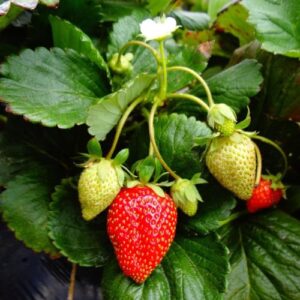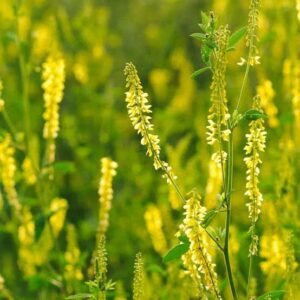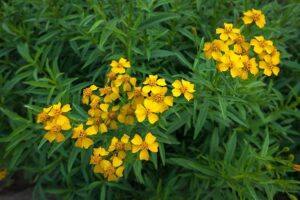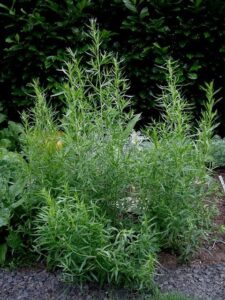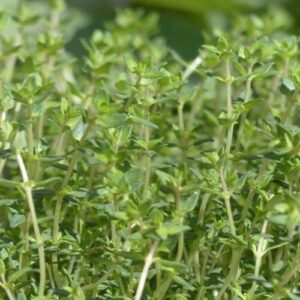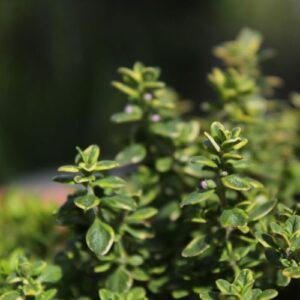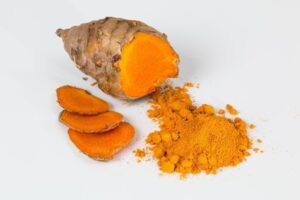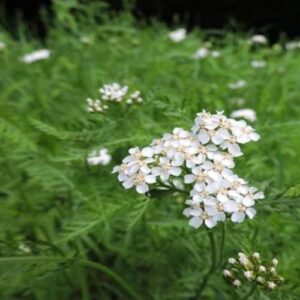Meet The Herbs
Aloe Vera (Aloe barbadensis miller)
🍃 Flavor & Aroma: Bitter, cooling, with a mild cucumber-like taste (gel only).
🍴 Uses: Gel used in skin care, burns, and drinks. Not typically used as a culinary herb, but the inner gel is edible in moderation.
✨ Benefits: Soothes burns and skin irritation; supports hydration and digestion.
🌱 Growth: Succulent perennial; grows 30–60 cm tall. Prefers dry, sandy soil and full sun.
- Planting: Best grown in pots or sandy garden beds in full sun. Ideal for windowsills, patios, or dry, warm spots outdoors.
- Care: Requires well-draining, gritty soil (cactus mix works well). Avoid frequent feeding; fertilize only once or twice a year. Protect from frost by moving pots indoors in winter. Remove offsets (‘pups’) to propagate and prevent overcrowding.
- Water: Low requirement. Allow soil to dry completely between waterings; water deeply but infrequently. Overwatering may cause root rot.
Anise (Pimpinella anisum)
🍃 Flavor & Aroma: Sweet, licorice-like taste.
🍴 Uses: Seeds used in baking, liqueurs, and herbal teas. Fresh leaves can be used in salads.
✨ Benefits: Traditionally aids digestion, freshens breath, and soothes coughs.
🌱 Growth: Annual; grows 40–60 cm tall. Prefers full sun.
- Planting: Best sown directly into garden beds in full sun, as plants don’t transplant well. Needs light, well-drained soil. Avoid heavy clay soils.
- Care: Thin seedlings to 15–20 cm apart. Stake taller plants to prevent lodging in windy areas. Harvest seeds when flower heads turn brown.
- Water: Moderate. Keep soil evenly moist, particularly during germination and flowering.
Asparagus (Asparagus officinalis)
🍃 Flavor & Aroma: Mild, slightly sweet, grassy taste.
🍴 Uses: Young shoots eaten steamed, roasted, or grilled.
✨ Benefits: High in vitamins A, C, and K; supports digestion and kidney health.
🌱 Growth: Hardy perennial; shoots harvested in spring. Ferny foliage grows 1–2 m tall. Prefers full sun and rich, well-drained soil.
- Planting: Best in raised beds or rows with sandy, well-drained soil. Plant crowns 30–40 cm apart in trenches. Needs full sun.
- Care: Takes 2–3 years to establish before regular harvesting. Cut back ferny growth after it yellows in autumn. Mulch beds yearly to suppress weeds and retain soil warmth.
- Water: Moderate. Keep soil moist during establishment; once mature, water deeply but less often.
Artichoke (Cynara scolymus)
🍃 Flavor & Aroma: Mild, nutty, earthy flavor.
🍴 Uses: Flower buds (hearts and bases of bracts) steamed, grilled, or preserved.
✨ Benefits: Supports liver health, digestion, and rich in antioxidants.
🌱 Growth: Perennial thistle; grows 1.2–1.5 m tall. Needs full sun and fertile soil.
- Planting: Best grown in large garden beds with plenty of space. Prefers full sun and rich, deep, well-drained soil. Not ideal for small pots.
- Care: Apply compost or manure annually for fertility. Remove side shoots to direct energy into main buds. Cut back stems after flowering. Protect crowns in frost-prone areas with mulch.
- Water: Moderate to high. Water regularly to encourage large, tender buds, but avoid soggy soil.
Basil (Sweet) (Ocimum basilicum)
🍃 Flavor & Aroma: Sweet, aromatic, classic basil flavor.
🍴 Uses: Essential in pesto, pasta, and salads. Pairs well with tomatoes.
✨ Benefits: Rich in antioxidants and vitamins; supports digestion.
🌱 Growth: Annual; grows 30–60 cm tall. Prefers warm weather and sun.
- Planting: Prefers sunny, sheltered spots or pots. Grows well alongside tomatoes and peppers.
- Care: Pinch flowers and harvest regularly for best growth. Sensitive to cold—grow as a warm-season annual.
- Water: Moderate. Keep soil consistently moist; mulch helps retain water.
Basil Dark Opal (Ocimum basilicum var. purpurascens)
🍃 Flavor & Aroma: Milder than sweet basil, with slight spice.
🍴 Uses: Used in salads, oils, and vinegars; ornamental purple foliage.
✨ Benefits: Similar health benefits to sweet basil.
🌱 Growth: Annual; grows 30–45 cm tall. Prefers sun.
- Planting: Prefers full sun in well-drained soil. Excellent for pots or decorative beds. Plant near tomatoes as a companion.
- Care: Pinch back stems to prevent flowering and encourage bushy growth. Harvest regularly. Protect from cold, as it is frost-sensitive.
- Water: Moderate. Keep soil moist but avoid standing water.
Basil Holy Green (Ocimum tenuiflorum)
🍃 Flavor & Aroma: Strong, peppery, clove-like flavor with a hint of sweetness.
🍴 Uses: Used fresh in teas, curries, stir-fries, and traditional Ayurvedic remedies.
✨ Benefits: Adaptogenic herb; supports stress relief, immunity, and respiratory health.
🌱 Growth: Annual or short-lived perennial; grows 30–60 cm tall. Prefers warm climates and full sun.
- Planting: Needs warm temperatures and lots of sunlight. Ideal for outdoor beds or pots in summer.
- Care: Pinch off flowers to extend leaf harvest. Protect from cold and frost. Harvest regularly for continuous growth.
- Water: Moderate. Water when topsoil feels dry, keeping soil consistently moist but not soggy.
Basil Lemon (Ocimum × citriodorum)
🍃 Flavor & Aroma: Fresh citrusy lemon scent.
🍴 Uses: Perfect for fish, salads, and teas.
✨ Benefits: Refreshing aroma, helps digestion.
🌱 Growth: Annual; grows 30–60 cm tall. Needs warmth and sun.
- Planting: Ideal in pots or borders in sunny locations. Prefers fertile, well-drained soil.
- Care: Pinch off flower buds to keep leaves tender and flavorful. Harvest regularly to promote fresh growth. Sensitive to frost.
- Water: Moderate. Keep soil evenly moist, watering more often in hot weather.
Basil Licorice (Ocimum basilicum var. anisatum)
🍃 Flavor & Aroma: Distinct anise/licorice taste.
🍴 Uses: Great for Asian dishes, poultry, and teas.
✨ Benefits: Digestive support, aromatic oils.
🌱 Growth: Annual; grows 30–60 cm tall.
- Planting: Best in sunny beds or pots with fertile, well-drained soil. Pair with tomatoes for enhanced growth.
- Care: Pinch tips regularly to prevent flowering. Protect from wind and cold. Use fresh for best flavor.
- Water: Moderate. Keep soil moist but not soggy.
Basil Siam Queen (Ocimum basilicum var. thyrsiflora)
🍃 Flavor & Aroma: Spicy, anise-like flavor.
🍴 Uses: Key herb in Thai cuisine, curries, and stir-fries.
✨ Benefits: Rich in antioxidants; aromatic oils have antibacterial effects.
🌱 Growth: Annual; grows 40–60 cm tall. Prefers warm sun.
- Planting: Needs a warm, sunny spot in fertile soil or pots. Great for indoor windowsills in cooler regions.
- Care: Regularly harvest young shoots to keep growth bushy. Protect from cold drafts. Pinch flowers to maintain leaf production.
- Water: Moderate. Keep soil moist but not waterlogged.
Borage (Borago officinalis)
🍃 Flavor & Aroma: Cucumber-like taste.
🍴 Uses: Leaves used fresh in salads, drinks, and garnishes. Star-shaped blue flowers are edible.
✨ Benefits: Attracts pollinators, high in gamma-linolenic acid (GLA).
🌱 Growth: Annual; grows 60–100 cm tall. Self-seeds easily.
- Planting: Direct sow in full sun; borage doesn’t transplant well. Prefers well-drained soil. Great as a companion plant for strawberries and tomatoes.
- Care: Low-maintenance plant. Remove faded flowers to prolong blooming. Thin seedlings for airflow. Can self-seed prolifically if not managed.
- Water: Moderate. Water regularly in dry periods, but avoid waterlogged soil.
Calendula (Calendula officinalis)
🍃 Flavor & Aroma: Mildly spicy, peppery, and tangy.
🍴 Uses: Petals used in salads, soups, teas, and as a saffron substitute for color. Widely used in skin creams and balms.
✨ Benefits: Traditionally used for wound healing, soothing skin, and digestive support.
🌱 Growth: Annual; grows 30–60 cm tall. Prefers full sun and well-drained soil.
- Planting: Best grown in garden beds or pots in full sun. Prefers fertile, well-drained soil. Can tolerate light shade.
- Care: Deadhead spent blooms to extend flowering. Collect petals for use when flowers are fully open. Self-seeds easily if left to mature.
- Water: Moderate. Keep soil evenly moist but not soggy.
Cancer Bush (Sutherlandia frutescens)
🍃 Flavor & Aroma: Bitter, slightly nutty, with a faint herbal aftertaste.
🍴 Uses: Traditionally brewed as a tea; used in tinctures and herbal tonics.
✨ Benefits: Known in African traditional medicine for immune support, energy boosting, and helping with colds, flu, and stress.
🌱 Growth: Hardy perennial shrub; grows 0.5–1.5 m tall. Thrives in dry, sunny areas with well-drained soil.
- Planting: Plant in sunny, well-drained beds. Thrives in arid conditions. Suitable for xeriscaping.
- Care: Low-maintenance once established. Prune lightly to shape. Protect young plants from frost.
- Water: Low. Drought-tolerant; water sparingly once established.
Catnip (Nepeta cataria)
🍃 Flavor & Aroma: Minty, slightly citrus-like.
🍴 Uses: Teas, cat stimulant (for play).
✨ Benefits: Traditionally calming for humans; stimulating for cats.
🌱 Growth: Perennial; grows 60–100 cm tall. Hardy and spreads easily.
- Planting: Plant in full sun to partial shade. Grows well in garden beds or pots. Prefers average, well-drained soil.
- Care: Cut back after flowering to encourage a second bloom. Can spread aggressively; grow in containers if needed.
- Water: Moderate. Water regularly during dry spells but avoid waterlogging.
Chamomile (Matricaria chamomilla / Chamaemelum nobile)
🍃 Flavor & Aroma: Apple-like fragrance.
🍴 Uses: Teas, soothing remedies, skin care.
✨ Benefits: Calming, supports sleep and digestion.
🌱 Growth: Annual (German) or perennial (Roman). Grows 15–60 cm tall.
- Planting: Sow directly into well-drained soil in a sunny spot. Roman chamomile is better for lawns or groundcover.
- Care: Harvest flowers regularly to encourage new blooms. Trim plants back if they become leggy.
- Water: Moderate. Keep soil moist, especially during germination and early growth.
Chervil (Anthriscus cerefolium)
🍃 Flavor & Aroma: Mild, delicate, slight anise taste.
🍴 Uses: Classic French cuisine herb; used in soups, sauces, and egg dishes.
✨ Benefits: Traditionally supports digestion and circulation.
🌱 Growth: Annual; grows 30–60 cm tall. Prefers cool weather.
- Planting: Best grown in spring or autumn in partial shade. Prefers moist, fertile soil.
- Care: Harvest leaves young for best flavor. Allow some plants to flower and self-seed for continuous growth.
- Water: Moderate. Keep soil consistently moist.
Chinese Cabbage (Brassica rapa subsp. pekinensis)
🍃 Flavor & Aroma: Mild, sweet, crisp, slightly peppery.
🍴 Uses: Stir-fries, soups, salads, pickling (kimchi).
✨ Benefits: Rich in vitamins C and K; supports digestion and immunity.
🌱 Growth: Biennial but grown as an annual; grows 30–60 cm tall. Prefers cool weather and moist, fertile soil.
- Planting: Sow in early spring or late summer. Needs fertile, well-drained soil in full sun to partial shade.
- Care: Protect from pests like cabbage worms. Harvest heads when firm and compact.
- Water: Moderate to high. Keep soil moist, especially in warm weather.
Chives (Allium schoenoprasum)
🍃 Flavor & Aroma: Mild onion-like flavor with a hint of garlic.
🍴 Uses: Leaves used fresh in salads, soups, dips, baked potatoes, and as a garnish. Flowers are also edible.
✨ Benefits: Rich in vitamins A and C; supports immunity and digestion.
🌱 Growth: Perennial; grows 20–40 cm tall. Prefers full sun and moist, well-drained soil.
- Planting: Plant in garden beds or pots. Prefers sunny locations but tolerates partial shade.
- Care: Cut leaves regularly to encourage new growth. Divide clumps every 3–4 years.
- Water: Moderate. Keep soil evenly moist, especially during dry spells.
Citronella (Cymbopogon nardus / Cymbopogon winterianus)
🍃 Flavor & Aroma: Strong lemon-like scent with sharp citrus notes.
🍴 Uses: Essential oils, teas, insect repellent, culinary use in Asian dishes.
✨ Benefits: Repels mosquitoes; traditionally used for fevers and digestive issues.
🌱 Growth: Perennial grass; grows 1–1.5 m tall. Prefers warm, sunny climates and well-drained soil.
- Planting: Best in pots or directly in garden beds in warm climates. Needs full sun and space to grow.
- Care: Trim back regularly to maintain shape. Protect from frost in cooler areas by moving pots indoors.
- Water: Moderate to high. Keep soil moist, especially in summer.
Comfrey (Symphytum officinale)
🍃 Flavor & Aroma: Not commonly used in food (slightly bitter, hairy leaves).
🍴 Uses: Traditionally used in herbal medicine and as a compost/soil enricher. Leaves used externally in salves.
✨ Benefits: Historically used for bone and tissue healing (‘knitbone’).
🌱 Growth: Hardy perennial; grows 60–120 cm tall. Spreads easily.
- Planting: Best grown in garden beds as a perennial patch. Prefers full sun to partial shade in moist, fertile soil.
- Care: Cut back leaves several times a season for composting or salves. Can spread aggressively.
- Water: Moderate. Keep soil moist, especially in summer.
Coriander (Coriandrum sativum)
🍃 Flavor & Aroma: Fresh, citrusy, slightly peppery leaves; seeds have a warm, nutty, spicy flavor.
🍴 Uses: Leaves used fresh in salads, salsas, curries, and soups. Seeds used in spice blends, baking, and pickling.
✨ Benefits: Supports digestion, rich in antioxidants, may help regulate blood sugar.
🌱 Growth: Annual; grows 30–60 cm tall. Prefers full sun and well-drained soil. Bolts quickly in hot weather.
- Planting: Sow directly outdoors in spring or autumn for best results. Prefers cooler temperatures and sunny sites.
- Care: Harvest leaves regularly before plants flower. Allow some plants to go to seed for spice use or reseeding.
- Water: Moderate. Keep soil moist but not soggy, especially during germination.
Creeping Thyme (Thymus serpyllum)
🍃 Flavor & Aroma: Similar to common thyme but milder.
🍴 Uses: Culinary use similar to thyme; also popular as groundcover and ornamental.
✨ Benefits: Attracts pollinators, aromatic, low-maintenance.
🌱 Growth: Hardy perennial; grows 5–10 cm tall, spreading widely as groundcover.
- Planting: Best used as a groundcover in sunny, well-drained areas. Works well between paving stones.
- Care: Prune lightly after flowering to keep tidy. Minimal care needed once established.
- Water: Low. Drought-tolerant; water sparingly once established.
Dandelion (Taraxacum officinale)
🍃 Flavor & Aroma: Bitter, earthy, slightly nutty taste.
🍴 Uses: Leaves eaten fresh in salads, roots roasted for tea or coffee substitute, flowers used in syrups and wines.
✨ Benefits: Supports liver and kidney health, rich in vitamins A, C, and K.
🌱 Growth: Hardy perennial; grows 10–30 cm tall with deep taproot. Thrives in most soils and conditions.
- Planting: Plant in garden beds, lawns, or pots. Tolerates a wide range of soils and conditions.
- Care: Harvest leaves young for less bitterness. Flowers can be picked for syrups or wine. Roots dug in autumn for drying.
- Water: Low to moderate. Generally thrives without extra watering once established.
Dill (Anethum graveolens)
🍃 Flavor & Aroma: Fresh, tangy, slightly sweet with anise undertones.
🍴 Uses: Classic herb for pickling; used in fish dishes, salads, and sauces. Seeds used in breads and spice blends.
✨ Benefits: Traditionally supports digestion and soothes stomach discomfort.
🌱 Growth: Annual; grows 60–120 cm tall. Prefers full sun and well-drained soil.
- Planting: Sow directly outdoors in sunny beds. Prefers fertile, well-drained soil. Avoid transplanting as roots are delicate.
- Care: Harvest leaves frequently. Allow some plants to go to seed for spice use and reseeding. Protect from strong wind.
- Water: Moderate. Keep soil moist, especially during hot weather.
Echinacea (Echinacea purpurea)
🍃 Flavor & Aroma: Earthy, floral, slightly bitter.
🍴 Uses: Herbal teas, tinctures, capsules.
✨ Benefits: Traditionally supports immunity, helps with colds and flu.
🌱 Growth: Perennial; grows 60–120 cm tall. Prefers full sun and well-drained soil.
- Planting: Plant in sunny beds or borders. Tolerates poor soils but prefers well-drained ground. Space plants 30–45 cm apart.
- Care: Deadhead to prolong flowering. Cut stems back in winter. Divide clumps every 3–4 years.
- Water: Low to moderate. Drought-tolerant once established but benefits from watering in prolonged dry periods.
Fennel (Foeniculum vulgare)
🍃 Flavor & Aroma: Sweet, strong anise/licorice flavor.
🍴 Uses: Leaves, seeds, and bulbs are all edible; used in soups, salads, and roasted dishes. Seeds flavor liqueurs.
✨ Benefits: Supports digestion, freshens breath, may relieve bloating.
🌱 Growth: Hardy perennial (often grown as annual); grows 1–2 m tall. Prefers full sun.
- Planting: Best grown in full sun in fertile, well-drained soil. Sow directly outdoors. Keep separate from dill to avoid cross-pollination.
- Care: Harvest leaves and seeds as needed. Bulbs can be dug when swollen and tender. Remove spent stems in autumn.
- Water: Moderate. Keep soil evenly moist, especially during bulb formation.
Fenugreek (Trigonella foenum-graecum)
🍃 Flavor & Aroma: Strong, maple-like, nutty flavor.
🍴 Uses: Seeds used in curries, spice blends, and teas. Leaves eaten fresh or dried in Indian and Middle Eastern dishes.
✨ Benefits: Supports digestion, may regulate blood sugar, and enhances milk production in nursing mothers.
🌱 Growth: Annual; grows 30–60 cm tall. Prefers full sun and well-drained soil.
- Planting: Direct sow seeds in sunny garden beds. Prefers fertile, well-drained soil. Best grown in cool seasons.
- Care: Thin seedlings to prevent overcrowding. Harvest leaves young for best flavor. Collect seeds when pods turn yellow.
- Water: Moderate. Keep soil evenly moist but not soggy.
Feverfew (Tanacetum parthenium)
🍃 Flavor & Aroma: Bitter, herbal taste with a slight citrus note.
🍴 Uses: Traditionally brewed as tea or taken fresh in small amounts for medicinal purposes.
✨ Benefits: Historically used to relieve headaches, migraines, and inflammation.
🌱 Growth: Perennial; grows 30–60 cm tall. Prefers sun to partial shade and well-drained soil.
- Planting: Plant in sunny or lightly shaded spots in fertile, well-drained soil. Can be grown in borders or pots.
- Care: Deadhead flowers to extend blooming. Divide clumps every few years to rejuvenate plants.
- Water: Moderate. Water regularly during dry periods, but avoid waterlogging.
Garlic (Allium sativum)
🍃 Flavor & Aroma: Strong, pungent, spicy when raw; mellow and sweet when roasted.
🍴 Uses: Culinary staple in savory dishes worldwide; also used in pickles, sauces, and oils.
✨ Benefits: Supports heart health, antimicrobial, immune-boosting.
🌱 Growth: Perennial bulb (grown annually); grows 30–60 cm tall. Prefers full sun and fertile, well-drained soil.
- Planting: Plant cloves in autumn in well-drained, fertile beds. Space 10–15 cm apart. Needs full sun exposure.
- Care: Keep beds weed-free. Harvest bulbs when leaves turn yellow and flop over. Dry thoroughly before storing.
- Water: Moderate. Water regularly during growth, but reduce watering as bulbs mature.
Garlic Chives (Allium tuberosum)
🍃 Flavor & Aroma: Mild garlic flavor with chive freshness.
🍴 Uses: Leaves, flowers, and stems used in stir-fries, dumplings, soups, and garnishes.
✨ Benefits: Rich in vitamins A and C, supports immunity and digestion.
🌱 Growth: Perennial; grows 30–60 cm tall. Thrives in sun or partial shade.
- Planting: Plant in garden beds or pots. Prefers fertile, well-drained soil. Space plants 15–20 cm apart.
- Care: Cut leaves regularly to encourage new growth. Divide clumps every 3–4 years to maintain vigor.
- Water: Moderate. Keep soil evenly moist, especially during hot weather.
Ginger (Zingiber officinale)
🍃 Flavor & Aroma: Warm, spicy, pungent, and slightly sweet.
🍴 Uses: Widely used in teas, curries, stir-fries, baked goods, and pickles.
✨ Benefits: Supports digestion, reduces nausea, anti-inflammatory, and boosts circulation.
🌱 Growth: Perennial root crop; grows from rhizomes 0.5–1 m tall. Prefers warm, humid climates with rich, moist soil.
- Planting: Plant rhizome pieces in pots or directly in the ground in warm climates. Needs partial shade to filtered sun.
- Care: Mulch to retain soil moisture. Harvest rhizomes after 8–10 months when leaves yellow. Store in cool, dry place.
- Water: High. Keep soil consistently moist, but not waterlogged.
Golden Marjoram (Origanum vulgare ‘Aureum’)
🍃 Flavor & Aroma: Milder than oregano, slightly sweet, with ornamental golden leaves.
🍴 Uses: Fresh or dried in Mediterranean dishes, soups, and sauces. Adds both flavor and color to gardens.
✨ Benefits: Digestive aid; aromatic and antioxidant-rich.
🌱 Growth: Perennial; grows 20–30 cm tall. Prefers sun.
- Planting: Plant in full sun in well-drained soil. Works well in rock gardens, borders, or pots.
- Care: Trim regularly to keep compact. Harvest leaves before flowering for best flavor.
- Water: Low to moderate. Water during prolonged dry periods.
Horehound (Marrubium vulgare)
🍃 Flavor & Aroma: Bitter, earthy, slightly minty.
🍴 Uses: Herbal teas, cough drops, candies, and syrups.
✨ Benefits: Traditionally used to soothe coughs and aid digestion.
🌱 Growth: Hardy perennial; grows 30–60 cm tall. Prefers dry, sunny soils.
- Planting: Plant in full sun in poor, dry soil. Excellent for low-maintenance gardens.
- Care: Cut back after flowering to prevent self-seeding. Divide clumps every 3–4 years if overcrowded.
- Water: Low. Very drought-tolerant once established.
Hyssop (Hyssopus officinalis)
🍃 Flavor & Aroma: Strong, slightly bitter, minty and camphor-like.
🍴 Uses: Used sparingly in soups, stews, liqueurs, and teas. Traditionally medicinal.
✨ Benefits: Historically used for respiratory relief and as a cleansing herb.
🌱 Growth: Perennial; grows 30–60 cm tall. Prefers sunny, well-drained soil.
- Planting: Best planted in sunny borders or herb gardens. Prefers well-drained soil. Space 30 cm apart.
- Care: Prune after flowering to keep compact. Divide clumps every 3–4 years.
- Water: Low to moderate. Water occasionally in dry weather.
Jerusalem Artichoke (Helianthus tuberosus)
🍃 Flavor & Aroma: Nutty, sweet, similar to water chestnut or potato.
🍴 Uses: Tubers eaten roasted, boiled, mashed, or raw in salads.
✨ Benefits: High in inulin (prebiotic fiber), supports gut health and energy.
🌱 Growth: Hardy perennial; grows 1.5–3 m tall with sunflower-like blooms. Prefers sun and sandy soil.
- Planting: Plant tubers directly into ground in sunny, sandy soil. Space 30–45 cm apart.
- Care: Cut stems back after frost. Harvest tubers in late autumn. Can spread aggressively—contain if needed.
- Water: Moderate. Water regularly during dry spells for larger tubers.
Julip Mint (Mentha spicata var. crispa)
🍃 Flavor & Aroma: Bright, refreshing spearmint-like flavor.
🍴 Uses: Famous for use in mint julep cocktails; also good in teas and desserts.
✨ Benefits: Refreshing, cooling, aids digestion.
🌱 Growth: Perennial; grows 45–75 cm tall. Prefers sun to partial shade.
- Planting: Best in containers to prevent spreading. Plant in fertile, moist soil.
- Care: Cut back regularly to encourage fresh growth. Divide clumps every 2–3 years.
- Water: High. Keep soil evenly moist, especially in summer.
Lavender Elegance (Lavandula angustifolia ‘Elegance’)
🍃 Flavor & Aroma: Soft, sweet lavender fragrance.
🍴 Uses: Used in teas, baking, sachets, and oils.
✨ Benefits: Calming, supports sleep and stress relief.
🌱 Growth: Compact perennial; grows 25–35 cm tall. Ideal for pots and edging.
- Planting: Best in sunny, well-drained soil. Grow in pots or borders. Requires good air circulation.
- Care: Prune after flowering to maintain shape. Remove faded blooms to encourage reblooming.
- Water: Low. Drought-tolerant once established.
Lavender Margaret Roberts (Lavandula × intermedia ‘Margaret Roberts’)
🍃 Flavor & Aroma: Sweet, floral lavender scent.
🍴 Uses: Popular in cooking, teas, oils, and crafts. Known as a South African garden favorite.
✨ Benefits: Promotes relaxation, aids sleep, supports skin health.
🌱 Growth: Hardy perennial shrub; grows 1–1.5 m tall. Prefers full sun.
- Planting: Grow in well-drained soil with full sun. Space 60 cm apart. Excellent for hedges.
- Care: Prune annually to keep bushy. Harvest flowers just before fully open.
- Water: Low. Water sparingly once established.
Lavender Stoechas (Spanish Lavender) (Lavandula stoechas)
🍃 Flavor & Aroma: Strong, camphor-like lavender fragrance.
🍴 Uses: Flowers used sparingly in baking, teas, potpourri, and essential oils.
✨ Benefits: Traditionally used for calming, relaxation, and antimicrobial purposes.
🌱 Growth: Hardy perennial shrub; grows 30–60 cm tall. Prefers full sun and dry soil.
- Planting: Best in sandy, well-drained soil with full sun. Space plants 30 cm apart.
- Care: Prune after flowering to maintain compact growth. Protect in colder climates.
- Water: Low. Requires minimal water once established.
Lemon Balm (Melissa officinalis)
🍃 Flavor & Aroma: Fresh lemon scent with mild mint undertones.
🍴 Uses: Leaves used in teas, salads, desserts, and as garnish. Popular in calming remedies.
✨ Benefits: Traditionally used to ease stress, support sleep, and aid digestion.
🌱 Growth: Perennial; grows 45–90 cm tall. Thrives in sun to partial shade and moist, fertile soil.
- Planting: Grow in garden beds or pots in sun or partial shade. Prefers rich, moist soil.
- Care: Trim regularly to prevent legginess. Cut back hard at least once a year to encourage new growth.
- Water: Moderate. Keep soil evenly moist, especially in hot weather.
Lemon Grass (Cymbopogon citratus)
🍃 Flavor & Aroma: Fresh, lemony, slightly spicy.
🍴 Uses: Soups, teas, curries, stir-fries, and essential oils.
✨ Benefits: Supports digestion, calming aroma, antimicrobial properties.
🌱 Growth: Perennial grass; grows 1–1.5 m tall. Prefers warm, humid climates and full sun.
- Planting: Plant in clumps in sunny, fertile, well-drained soil. Suitable for pots in cooler regions.
- Care: Cut stems regularly to encourage fresh growth. Protect from frost by overwintering indoors.
- Water: Moderate to high. Keep soil moist in warm seasons.
Lovage (Levisticum officinale)
🍃 Flavor & Aroma: Strong celery-like taste with hints of anise.
🍴 Uses: Soups, stews, salads, and teas.
✨ Benefits: Supports digestion and kidney function.
🌱 Growth: Hardy perennial; grows 1.5–2 m tall. Prefers moist, fertile soil in sun or partial shade.
- Planting: Best in garden beds with deep, fertile soil. Space plants 60–90 cm apart.
- Care: Cut stems to ground in autumn. Divide clumps every 3–4 years.
- Water: Moderate. Keep soil consistently moist, especially in hot weather.
Marigold (Tagetes spp.)
🍃 Flavor & Aroma: Peppery, citrusy, and slightly bitter (varies by species).
🍴 Uses: Petals used in teas, salads, and as a natural food colorant. Also valued as a companion plant in gardens.
✨ Benefits: Traditionally used for skin soothing, digestive support, and pest deterrence in gardens.
🌱 Growth: Annual or perennial depending on species; grows 20–90 cm tall. Thrives in full sun and well-drained soil.
- Planting: Direct sow in sunny beds or pots. Easy to grow from seed. Prefers fertile, well-drained soil.
- Care: Deadhead spent blooms to encourage flowering. Remove old plants at season’s end.
- Water: Moderate. Water regularly, especially during dry spells.
Mentha Penny Royal (Mentha pulegium)
🍃 Flavor & Aroma: Strong, pungent, minty aroma.
🍴 Uses: Traditionally used in teas and herbal medicine; not common in modern culinary use.
✨ Benefits: Historically used as digestive aid and insect repellent (caution: potent).
🌱 Growth: Perennial; grows 30–60 cm tall. Thrives in moist soil and sun to partial shade.
- Planting: Best in pots or contained areas to control spreading. Prefers moist soils.
- Care: Trim regularly to prevent legginess. Divide plants every 2–3 years to maintain vigor.
- Water: High. Requires consistently moist soil.
Mexican Mint (Plectranthus amboinicus)
🍃 Flavor & Aroma: Strong, oregano-like flavor with hints of thyme and sage.
🍴 Uses: Leaves used in teas, curries, soups, and as a substitute for oregano.
✨ Benefits: Supports respiratory and digestive health; traditionally used for coughs and colds.
🌱 Growth: Perennial; grows 30–90 cm tall. Prefers warm climates and partial sun.
- Planting: Grow in pots or beds in warm climates. Prefers partial sun and well-drained soil.
- Care: Pinch back regularly to encourage bushy growth. Protect from frost.
- Water: Moderate. Water regularly but allow soil to dry slightly between waterings.
Mint (Mentha spp.)
🍃 Flavor & Aroma: Fresh, cooling, sweet, and aromatic.
🍴 Uses: Teas, desserts, sauces, salads, and garnishes. Versatile culinary herb.
✨ Benefits: Supports digestion, freshens breath, and may relieve headaches.
🌱 Growth: Perennial; grows 30–90 cm tall. Spreads vigorously—best grown in pots or contained beds.
- Planting: Best in containers to control spreading. Prefers sun to partial shade. Can also be used as groundcover in a contained area.
- Care: Cut back regularly to prevent legginess and encourage fresh growth. Divide plants every 2–3 years to maintain vigor.
- Water: High. Keep soil evenly moist, especially in hot weather, but avoid soggy conditions.
Mint Apple (Mentha suaveolens)
🍃 Flavor & Aroma: Sweet, fruity apple-like aroma with a mild mint flavor.
🍴 Uses: Leaves used in teas, fruit salads, and sauces. Popular for garnishes and desserts.
✨ Benefits: Traditionally used for soothing digestion and calming teas.
🌱 Growth: Perennial; grows 40–80 cm tall. Thrives in sun to partial shade.
- Planting: Plant in containers to prevent invasive spreading. Prefers rich, moist soil.
- Care: Cut back regularly to encourage bushy growth. Divide plants every 2–3 years.
- Water: High. Requires consistently moist soil.
Mint Chocolate (Mentha × piperita ‘Chocolate’)
🍃 Flavor & Aroma: Distinct chocolate-mint aroma and flavor.
🍴 Uses: Excellent for desserts, teas, hot chocolate, and garnishes.
✨ Benefits: Cooling and digestive; aromatic and uplifting.
🌱 Growth: Perennial; grows 30–60 cm tall. Prefers sun to partial shade.
- Planting: Best grown in containers or contained beds. Prefers fertile, moist soil.
- Care: Cut back stems to promote fresh growth. Divide clumps every few years to maintain vigor.
- Water: High. Keep soil evenly moist, especially in summer.
Mint Pineapple (Mentha suaveolens var. variegata)
🍃 Flavor & Aroma: Fruity, pineapple-like scent with mild mint taste.
🍴 Uses: Leaves used in fruit salads, drinks, desserts, and teas. Attractive variegated foliage for garnishes.
✨ Benefits: Refreshing and soothing; supports digestion and cooling in hot weather.
🌱 Growth: Perennial; grows 30–60 cm tall. Prefers sun to partial shade.
- Planting: Best in containers to control spreading. Prefers fertile, moist, well-drained soil.
- Care: Trim regularly to prevent legginess. Protect from frost in cooler climates.
- Water: High. Keep soil evenly moist.
Mugwort (Artemisia vulgaris)
🍃 Flavor & Aroma: Bitter, earthy, slightly sage-like.
🍴 Uses: Traditionally used in teas, herbal remedies, and rituals. Leaves flavor meats in some cuisines.
✨ Benefits: Historically used to support digestion, relieve fatigue, and in folk medicine.
🌱 Growth: Hardy perennial; grows 1–2 m tall. Can spread aggressively.
- Planting: Best grown in sunny beds with well-drained soil. Tolerates poor soils.
- Care: Cut back regularly to control spreading. Can be invasive if unchecked.
- Water: Low to moderate. Very hardy and drought-tolerant once established.
Mustard Spinach Green (Brassica rapa var.)
🍃 Flavor & Aroma: Mild mustard-like flavor with a spinach-like texture.
🍴 Uses: Eaten fresh in salads, stir-fries, soups, or lightly steamed.
✨ Benefits: Rich in vitamins A, C, and K; supports immune health and digestion.
🌱 Growth: Annual leafy green; grows 20–40 cm tall. Prefers cool weather.
- Planting: Direct sow seeds in fertile soil in spring or autumn. Space 20–30 cm apart.
- Care: Harvest leaves regularly to encourage new growth. Protect from pests like aphids.
- Water: Moderate. Keep soil evenly moist.
Nasturtium (Tropaeolum majus)
🍃 Flavor & Aroma: Peppery, similar to watercress, with edible flowers and leaves.
🍴 Uses: Flowers and leaves used in salads, garnishes, pestos, and pickles. Seeds sometimes used as caper substitutes.
✨ Benefits: Rich in vitamin C; supports immunity. Attracts pollinators and repels garden pests.
🌱 Growth: Annual; trailing or climbing habit. Prefers full sun to partial shade.
- Planting: Sow directly in garden beds, pots, or hanging baskets. Prefers poor to average soil for best flowering.
- Care: Requires little care. Deadhead to prolong blooming. Can self-seed easily.
- Water: Moderate. Water during dry spells but avoid overwatering
Oregano (Origanum vulgare)
🍃 Flavor & Aroma: Pungent, earthy, slightly bitter with warming notes.
🍴 Uses: Classic Mediterranean herb for pizzas, sauces, meats, and vegetables.
✨ Benefits: Contains antioxidants and antimicrobial compounds; supports digestion.
🌱 Growth: Perennial; grows 30–60 cm tall. Prefers full sun and well-drained soil.
- Planting: Grow in garden beds or pots in sunny spots. Space plants 30 cm apart.
- Care: Trim regularly to encourage bushy growth. Harvest leaves before flowering for best flavor.
- Water: Low to moderate. Drought-tolerant once established.
Parsley Italian (Petroselinum crispum var. neapolitanum)
🍃 Flavor & Aroma: Fresh, slightly peppery, stronger flavor than curly parsley.
🍴 Uses: Used in sauces, salads, soups, tabbouleh, and garnishes.
✨ Benefits: Rich in vitamins A, C, and K; supports kidney health and freshens breath.
🌱 Growth: Biennial (grown as annual); grows 30–60 cm tall. Prefers full sun to partial shade.
- Planting: Direct sow in spring or autumn. Slow to germinate—soak seeds before planting.
- Care: Harvest leaves regularly to prevent bolting. Allow some plants to flower for seeds.
- Water: Moderate. Keep soil evenly moist, especially during germination.
Parsley Moss Curled (Petroselinum crispum var. crispum)
🍃 Flavor & Aroma: Milder, fresh, slightly peppery taste with curly leaves.
🍴 Uses: Common garnish; also used in soups, sauces, and salads.
✨ Benefits: High in vitamins A, C, and K; supports digestion and freshens breath.
🌱 Growth: Biennial (grown as annual); grows 20–40 cm tall.
- Planting: Direct sow in rich, moist soil. Prefers sun to partial shade.
- Care: Harvest leaves regularly. Can withstand cooler weather.
- Water: Moderate. Keep soil evenly moist.
Black Peppermint (Mentha × piperita ‘Black’)
🍃 Flavor & Aroma: Strong peppermint flavor with subtle earthy undertones.
🍴 Uses: Used in teas, desserts, sauces, and candies.
✨ Benefits: Soothes digestion, freshens breath, and relieves nausea.
🌱 Growth: Perennial; grows 30–90 cm tall. Prefers sun to partial shade.
- Planting: Best in containers to control spreading. Prefers fertile, moist soil.
- Care: Cut back stems regularly. Divide clumps every few years.
- Water: High. Requires consistently moist soil.
Portulacaria Afra (Spekboom)
🍃 Flavor & Aroma: Succulent, tangy, lemony leaves.
🍴 Uses: Leaves eaten fresh in salads or as trail snacks. Used in traditional remedies.
✨ Benefits: High in vitamin C; excellent carbon absorber, supports the environment.
🌱 Growth: Succulent shrub; grows 2–4 m tall in warm climates.
- Planting: Best in sandy, well-drained soil. Prefers sun to partial shade.
- Care: Prune to shape. Very hardy and resilient. Root easily from cuttings.
- Water: Low. Extremely drought-tolerant.
Red Vein Sorrel (Rumex sanguineus)
🍃 Flavor & Aroma: Tangy, lemony taste with slightly sour notes.
🍴 Uses: Leaves used in salads, soups, sauces, and garnishes.
✨ Benefits: Rich in vitamin C and iron; aids digestion.
🌱 Growth: Perennial; grows 30–60 cm tall. Distinct red-veined leaves.
- Planting: Plant in moist, fertile soil in sun or partial shade.
- Care: Harvest young leaves for best flavor. Remove flower stalks to prolong leaf harvest.
- Water: Moderate. Keep soil moist for tender leaves.
Rocket (Eruca sativa)
🍃 Flavor & Aroma: Peppery, nutty, slightly bitter taste.
🍴 Uses: Leaves eaten fresh in salads, sandwiches, and pestos.
✨ Benefits: Rich in antioxidants, vitamins A and C; supports digestion.
🌱 Growth: Annual leafy green; grows 20–40 cm tall. Prefers cool weather.
- Planting: Direct sow seeds in beds or pots. Prefers fertile, well-drained soil in sun or partial shade.
- Care: Harvest young leaves for milder flavor. Can bolt quickly in heat.
- Water: Moderate. Keep soil consistently moist.
Rosemary Barbecue (Rosmarinus officinalis ‘Barbecue’)
🍃 Flavor & Aroma: Strong rosemary flavor with woody stems ideal for skewers.
🍴 Uses: Used in roasts, grilling (stems as skewers), sauces, and marinades.
✨ Benefits: Supports digestion, improves circulation, and boosts memory.
🌱 Growth: Perennial shrub; grows 1–1.5 m tall. Prefers full sun and well-drained soil.
- Planting: Plant in sunny, well-drained beds or pots. Space 60 cm apart.
- Care: Prune after flowering. Protect in frost-prone areas.
- Water: Low. Drought-tolerant once established.
Rosemary Caprii (Rosmarinus officinalis ‘Caprii’)
🍃 Flavor & Aroma: Aromatic, pine-like rosemary taste.
🍴 Uses: Used in roasts, breads, sauces, and marinades.
✨ Benefits: Rich in antioxidants; supports digestion and circulation.
🌱 Growth: Compact perennial shrub; grows 60–90 cm tall.
- Planting: Best in sunny borders or pots with sandy, well-drained soil.
- Care: Prune lightly to maintain shape. Protect from severe frost.
- Water: Low. Requires minimal watering once established.
Rosemary Tanya (Rosmarinus officinalis ‘Tanya’)
🍃 Flavor & Aroma: Fragrant, strong rosemary aroma and flavor.
🍴 Uses: Common in cooking, teas, oils, and aromatherapy.
✨ Benefits: Traditionally used for memory and digestion.
🌱 Growth: Perennial shrub; grows 1–1.2 m tall. Prefers sun and dry soil.
- Planting: Plant in well-drained soil in sunny spots. Space plants 60 cm apart.
- Care: Trim regularly to maintain compact shape. Mulch roots in winter if frost is severe.
- Water: Low. Very drought-tolerant.
Rue Graveolens (Ruta graveolens)
🍃 Flavor & Aroma: Strong, bitter, pungent taste.
🍴 Uses: Used sparingly in Mediterranean cooking; traditional herbal medicine.
✨ Benefits: Traditionally used for digestive and anti-inflammatory properties.
🌱 Growth: Evergreen perennial; grows 60–90 cm tall. Prefers sun and well-drained soil.
- Planting: Plant in sunny borders or rock gardens. Space 30–40 cm apart.
- Care: Prune after flowering. Handle with care; sap may irritate skin.
- Water: Low. Thrives in dry, poor soil.
Rue Syrian (Ruta chalepensis)
🍃 Flavor & Aroma: Bitter, aromatic flavor similar to Rue Graveolens.
🍴 Uses: Used sparingly in regional Mediterranean dishes and traditional medicine.
✨ Benefits: Historically valued for digestive support and aromatic oils.
🌱 Growth: Perennial; grows 50–100 cm tall. Prefers dry, sunny sites.
- Planting: Best in sandy, well-drained soil in sun. Can grow in poor soils.
- Care: Prune lightly to control growth. Handle with gloves to avoid skin irritation.
- Water: Low. Very drought-resistant.
Sage (Salvia officinalis)
🍃 Flavor & Aroma: Earthy, slightly peppery, with a hint of pine and lemon.
🍴 Uses: Used in stuffing, sausages, sauces, and teas.
✨ Benefits: Traditionally aids memory, digestion, and sore throats.
🌱 Growth: Perennial; grows 30–60 cm tall. Prefers full sun and well-drained soil.
- Planting: Plant in sunny borders or pots. Prefers sandy or loamy soil with good drainage.
- Care: Prune after flowering to keep compact. Replace plants every 3–5 years as they become woody.
- Water: Low to moderate. Water sparingly; avoid soggy soil.
Sage Icterina (Salvia officinalis ‘Icterina’)
🍃 Flavor & Aroma: Mild, earthy sage flavor.
🍴 Uses: Culinary and ornamental; used in sauces, meats, and stuffings.
✨ Benefits: Same health benefits as common sage; antioxidant-rich.
🌱 Growth: Variegated perennial; grows 30–60 cm tall. Prefers sun and well-drained soil.
- Planting: Plant in well-drained, sandy soil. Best in sunny spots.
- Care: Trim back after flowering. Replace woody plants every few years.
- Water: Low. Tolerates dry conditions.
Sage Tricolour (Salvia officinalis ‘Tricolour’)
🍃 Flavor & Aroma: Milder sage flavor with ornamental foliage.
🍴 Uses: Primarily ornamental; occasionally used in cooking.
✨ Benefits: Similar benefits to common sage; attractive foliage for gardens.
🌱 Growth: Perennial; grows 30–60 cm tall. Variegated leaves with purple, white, and green.
- Planting: Best in sunny, well-drained beds. Works well as decorative edging.
- Care: Prune lightly to maintain foliage color. Replace plants every few years.
- Water: Low. Requires minimal watering.
Spearmint (Mentha spicata)
🍃 Flavor & Aroma: Sweet, refreshing mint flavor.
🍴 Uses: Used in teas, cocktails, sauces, and desserts.
✨ Benefits: Supports digestion, cooling, and refreshing.
🌱 Growth: Perennial; grows 30–90 cm tall. Prefers moist soil.
- Planting: Best in containers to prevent spreading. Prefers fertile, well-drained soil in sun or shade.
- Care: Cut back regularly to encourage new growth. Divide clumps every 2–3 years.
- Water: High. Requires consistently moist soil.
Spring Onion (Allium fistulosum)
🍃 Flavor & Aroma: Mild onion flavor with a fresh bite.
🍴 Uses: Used raw in salads, stir-fries, soups, and garnishes.
✨ Benefits: Rich in vitamins A, C, and K; supports immunity and heart health.
🌱 Growth: Biennial grown as annual; grows 30–60 cm tall.
- Planting: Sow directly in rows in full sun. Space plants 5–10 cm apart.
- Care: Harvest when stems reach pencil thickness. Succession sow for continuous supply.
- Water: Moderate. Keep soil moist but not waterlogged.
Spinach Fordhook (Spinacia oleracea ‘Fordhook Giant’)
🍃 Flavor & Aroma: Mild, earthy, slightly sweet flavor.
🍴 Uses: Leaves eaten fresh, steamed, or in soups and casseroles.
✨ Benefits: Rich in iron, vitamins A and C; supports energy and eye health.
🌱 Growth: Annual leafy green; grows 20–40 cm tall. Prefers cool weather.
- Planting: Direct sow seeds in rich soil in early spring or autumn. Space 10–15 cm apart.
- Care: Harvest outer leaves regularly. Bolts quickly in heat.
- Water: Moderate. Keep soil evenly moist.
Spinach Matador Baby (Spinacia oleracea ‘Matador Baby’)
🍃 Flavor & Aroma: Tender, mild, and slightly nutty taste.
🍴 Uses: Baby leaves eaten in salads; larger leaves used in cooking.
✨ Benefits: Nutrient-rich; supports immunity and energy levels.
🌱 Growth: Annual; grows 15–30 cm tall. Prefers cool weather.
- Planting: Sow seeds in early spring or autumn in fertile soil. Space 5–10 cm apart.
- Care: Harvest young leaves often. Protect from heat to avoid bolting.
- Water: Moderate. Keep soil moist for tender leaves.
Stevia (Stevia rebaudiana)
🍃 Flavor & Aroma: Intensely sweet leaves with no calories.
🍴 Uses: Leaves used fresh or dried as a natural sweetener in drinks, desserts, and teas.
✨ Benefits: Natural sugar substitute; may help manage blood sugar levels.
🌱 Growth: Tender perennial (often grown as annual); grows 30–60 cm tall. Prefers warm climates.
- Planting: Best grown in pots or sunny garden beds. Prefers fertile, well-drained soil.
- Care: Pinch tips to encourage bushiness. Harvest leaves before flowering for best sweetness.
- Water: Moderate. Keep soil consistently moist but not soggy.
Strawberry (Fragaria × ananassa)
🍃 Flavor & Aroma: Sweet, juicy, and fragrant berries.
🍴 Uses: Eaten fresh, in desserts, jams, and drinks.
✨ Benefits: Rich in vitamin C and antioxidants; supports heart health and immunity.
🌱 Growth: Perennial; low-growing plants with runners. Prefers full sun.
- Planting: Plant crowns in fertile, well-drained soil. Space 30 cm apart.
- Care: Mulch to keep fruit clean. Remove runners if not propagating. Protect from birds.
- Water: Moderate. Keep soil moist, especially during fruiting.
Sweet Yellow Clover (Melilotus officinalis)
🍃 Flavor & Aroma: Sweet, slightly vanilla-like aroma.
🍴 Uses: Used in teas, traditional medicine, and soil improvement (green manure).
✨ Benefits: Supports digestion, calming effects, and soil fertility.
🌱 Growth: Biennial; grows 1–2 m tall. Prefers sun and average soil.
- Planting: Sow seeds directly in garden beds or wildflower patches.
- Care: Cut back after flowering to prevent excessive self-seeding.
- Water: Low to moderate. Drought-tolerant once established.
Tarragon French (Artemisia dracunculus var. sativa)
🍃 Flavor & Aroma: Delicate anise-like flavor.
🍴 Uses: Used in sauces, chicken, fish, and vinegar infusions.
✨ Benefits: Aids digestion and appetite stimulation.
🌱 Growth: Perennial; grows 60–120 cm tall. Prefers sun and fertile, well-drained soil.
- Planting: Best propagated from cuttings. Plant in sunny spots in rich soil.
- Care: Cut back in autumn. Divide every 3–4 years.
- Water: Moderate. Keep soil moist but not soggy.
Tarragon Russian (Artemisia dracunculoides)
🍃 Flavor & Aroma: Milder, less intense than French tarragon.
🍴 Uses: Leaves used in salads, soups, and vinegar. Hardy alternative to French tarragon.
✨ Benefits: Traditionally supports digestion.
🌱 Growth: Perennial; grows 60–150 cm tall. Very hardy.
- Planting: Sow seeds or plant divisions in sunny, well-drained soil.
- Care: Cut back in autumn. Less maintenance than French tarragon.
- Water: Moderate. Water regularly but avoid overwatering.
Thyme (Thymus vulgaris)
🍃 Flavor & Aroma: Strong, earthy, slightly minty flavor.
🍴 Uses: Used in roasts, stews, soups, and sauces. Pairs well with meats and vegetables.
✨ Benefits: Antimicrobial, antioxidant-rich, supports immunity.
🌱 Growth: Hardy perennial; grows 20–40 cm tall. Prefers sun and well-drained soil.
- Planting: Plant in sunny, well-drained beds or pots. Excellent for borders or rock gardens.
- Care: Trim after flowering to keep compact. Harvest sprigs regularly.
- Water: Low. Drought-tolerant once established.
Thyme Lemon (Thymus citriodorus)
🍃 Flavor & Aroma: Bright lemon scent with mild thyme taste.
🍴 Uses: Great for poultry, fish, teas, and salads. Adds fresh citrus notes to cooking.
✨ Benefits: Digestive aid; uplifting aroma.
🌱 Growth: Hardy perennial; low-growing, 15–30 cm tall. Prefers sun.
- Planting: Plant in well-drained soil in sunny borders or pots. Works well as edging or groundcover.
- Care: Trim lightly after flowering to keep tidy. Harvest sprigs regularly.
- Water: Low. Drought-tolerant once established.
Turmeric (Curcuma longa)
🍃 Flavor & Aroma: Warm, earthy, slightly bitter, and peppery taste.
🍴 Uses: Rhizomes used fresh or dried in curries, teas, and as natural coloring.
✨ Benefits: Anti-inflammatory, antioxidant-rich, supports joint and digestive health.
🌱 Growth: Perennial root crop; grows 1–1.2 m tall. Prefers tropical to subtropical climates.
- Planting: Plant rhizome pieces in pots or beds in warm climates. Needs partial shade to full sun.
- Care: Mulch to keep soil moist and warm. Harvest rhizomes after 8–10 months when leaves yellow.
- Water: High. Keep soil moist but avoid waterlogging.
Yarrow (Achillea millefolium)
🍃 Flavor & Aroma: Bitter, aromatic, slightly astringent taste.
🍴 Uses: Leaves used sparingly in salads and teas. Flowers used in herbal remedies.
✨ Benefits: Traditionally supports wound healing, digestion, and circulation.
🌱 Growth: Perennial; grows 30–90 cm tall with clusters of flowers. Prefers sun.
- Planting: Plant in sunny, well-drained beds. Tolerates poor soils.
- Care: Cut back after flowering to promote new growth. Can spread easily if not managed.
- Water: Low. Very drought-tolerant once established.
Testimonials
★★★★★
Location
A Proudly Midvaal Business
Hours
Monday - Friday
8AM - 5PM
Saturday - Sunday
8AM - 2PM



